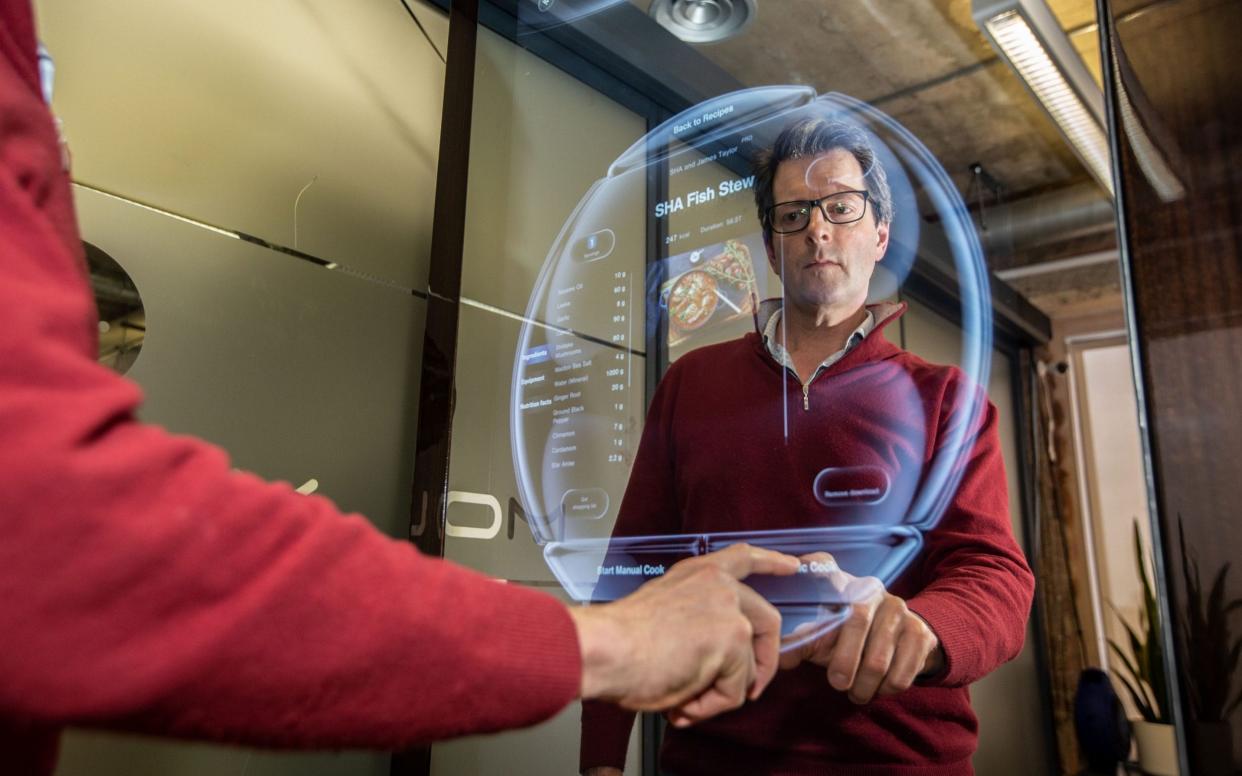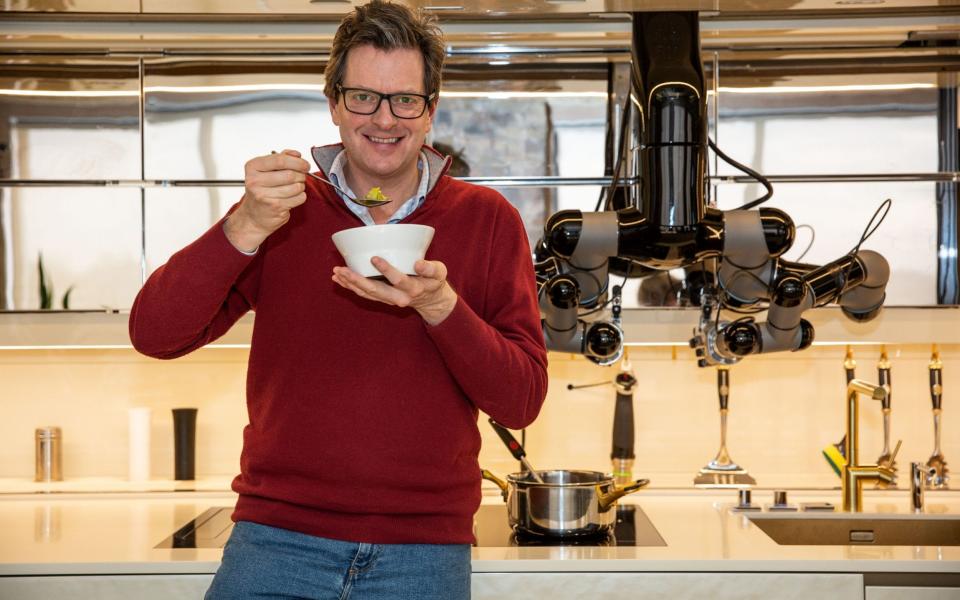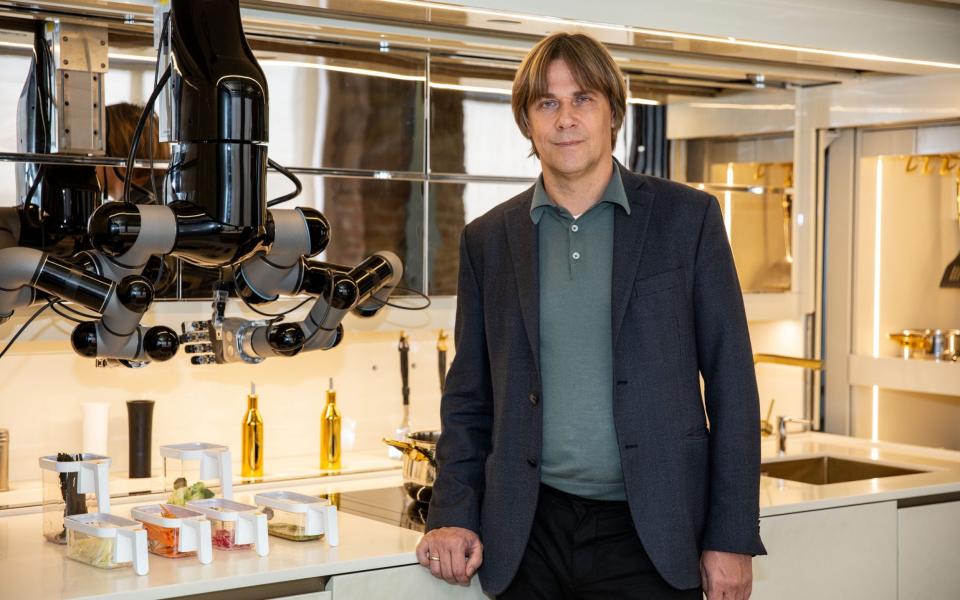My date with Robochef: the £250k kitchen gadget that makes your dinner

Across the decades and centuries men and women have endeavoured to create apparatus, machines and products that have promised to make life tastier, simpler or simply more fun.
And today I am face to face with an invention that aims to surpass them all. It’s cooking me lunch; fish stew, to be precise.
Denis Papin’s 17th century pressure cooker, the pop-up toaster of Charles Strite in 1919, Otto Frederick Rohwedder’s 1920s bread-slicing machine, Kenneth Wood’s Kenwood mixer of the late 1940s… these are all but kitchen froth in the light of what I am witnessing. In a laboratory in London’s Hammersmith I meet Robochef (Moley, to its engineers); the world’s first robotic kitchen.
A glistening outfit with ovens and hob, Moley also has various cupboards and drawers, a sink, hanging utensils and a robotic torso – actually make that a jumble of arms and hands – fixed to a bar in the ceiling. To the left is a large, futuristic touch screen. You can scroll around and then select a recipe, of which there are 1,000 loaded and at the robot’s disposal. I select a fish stew – it’s a cold day and I want something warming, light and tasty – touch start, and off goes Robochef. Well, sort of. More on this shortly.

“Invention is not a quick process,” says Mark Oleynik, its 49-year-old creator. From St Petersburg and with collar-length, straight floppy hair, trainers and a yellow watch, he looks a bit like a 1990s DJ.
“I have had different experiences in my life,” he tells me as he pauses between striding around talking on his phone and giving orders to his large coterie of twentysomething assistants, all dressed in black (it’s not a Bond villain uniform, they’re just millennials who dress like that).
Oleynik, who moved to London in 2008 and patented Moley in 2014, tells me of his background in computer science, of studying at the St Petersburg Nuclear Physics Institute, of graduating from the St Petersburg Institute of Aerospace Instrumentation, of running hardware and software projects, of developing new medicines for a pharmaceutical company. He rambles like any mad professor ought to: “My idea comes from the fact that I like interesting food, I try food in different countries but I find I cannot try enough new food. My options are limited. I have good memories, but I want to recover those memories. Except I cannot. So my idea is to create a machine that generates everything, from the molecule to the dish. Imagine one day if it is possible to have a black box. In one side you put in a plate, on the other out comes a chicken dish.”
But that’s not Moley – which costs £250,000 (and includes the robot, furniture and cooking appliances) – that’s just him dreaming. As to the here and now: “The process of a chef is very difficult to recreate, the sequence of preparation is so complex. The machine cannot feel or smell, but what it can do is follow instructions with very high precision.”
The Moley team commissions recipes from chefs they respect: my fish stew was developed by a chef at a health resort in Spain. They then film the chef cooking and program the robot to imitate every action – from grabbing a pan to filling it with water, adding ingredients, stirring and so on.
And thus the cooking of my fish stew begins. But not until the male assistants have placed small plastic containers of prepared ingredients in the fridge, which is located behind a mirrored door.
“Doesn’t the robot prep food?” I ask.
“There are companies that will do the prep,” splutters Oleynik. Silly me. The food prep idea is in development.

Over the next 55 minutes I watch as the robot moves about the kitchen – up and down, left and right – cooking my stew. Everything seems painstakingly slow. It moves to the left, for example, while the fridge door gently opens, then moves back, the right hand takes hold of a tub of onions, then it retreats back to the left position and waits while the fridge door closes. Next it stands over the pan and scoops the onions in, cleverly scooping again to check there are none left in the tub. Of course the idea is that you don’t watch this process – the intrigue would soon wear off so you can get on with other stuff, like watching telly, while your food is prepared.
Oleynik reckons he will sell 10 Moleys this year and claims to have 1,200 “qualified sales inquiries”.
We need to reduce the price and build low-price models,” he adds; the customer of the future, he thinks, will be “people who can’t cook or seniors; grandmothers and grandfathers who need access to really fresh food.”

After 55 minutes Moley is done, it gives me a thumbs up and I help myself to a large bowl of fish stew. It’s delicious: tasty, fresh, the fish – hake – is cooked perfectly and the veggies nicely al dente.
I ask another niggling question. It doesn’t prep food, but does it wash up? “It can clean the surface,” Oleynick explains eagerly. “And it will load dishes into the dishwasher,” he says, adding rather crucially, “soon.” Moley also can’t cook more than one dish at a time. So for a quarter of a million quid that’s a one-course meal, or a very, very long dinner.
I’ve seen the culinary future, and it tastes good. But it’s pricey, slow and – until Moley develops some conversational skills – very dull.
For more details on Moley, go to moley.com/kitchen
Five of the most useless kitchen gadgets from yesteryear
By Alice Hall
The deep fat fryer
Back in the less health conscious 1950s, a quick weekday supper often called for something deep-fried in litres of oil. The thermostatic fryer had all the allure of running your own chip shop (yes, that much), and without the risk of a hideous pan fire. Not surprisingly, it fell rapidly out of favour at the dawn of the fitness-minded 1980s.
The teasmade
Waking up and smelling the Typhoo became a reality with the rollout of the electric automatic tea maker. Invented in the 1930s, the teasmade became a household staple during the 1960s. What could be nicer than being woken by a fresh cuppa on your bedside? Not being woken by its shrill alarm and a gurgle of water being heated next to your sleepy head, for starters.
The automated spaghetti fork
A fork that does all the hard work of twirling strands of pasta for you. Yes, really: no wrist action required. Inexplicably popular in the 1990s, it would have Italian chefs turning in their graves.
The fondue set
Nothing says the 1970s quite like a fondue party. While it feels like fun and games at first, those who own one will know that the novelty of gathering round a bubbling pot of cheese wears off very quickly. You try getting bits of burnt cheese off it at the end of the night…
The egg cooker
A terrible 1990s brainwave. They can scramble, poach, boil, steam and even sous vide up to six eggs at a time – but who wants a hatchery staring at you from the kitchen worktop? Plus, who is too distracted to bring a pan of water to the boil?

